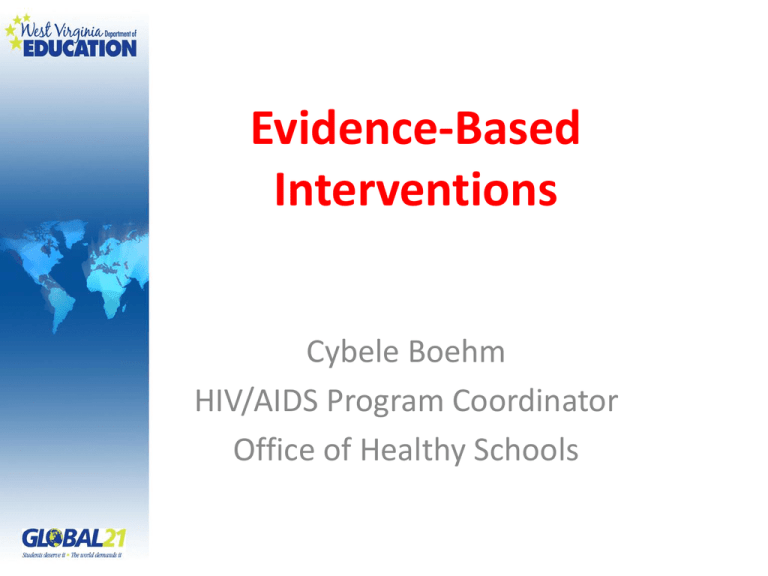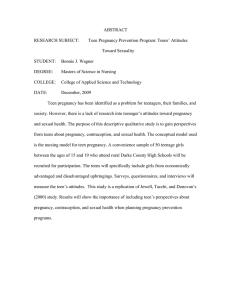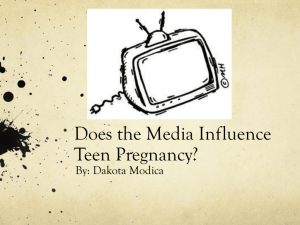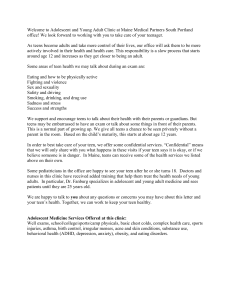
Evidence-Based
Interventions
Cybele Boehm
HIV/AIDS Program Coordinator
Office of Healthy Schools
Objectives
• Define Evidence-Based Interventions
• Discuss the benefits of implementing
Evidence-Based Interventions in
school settings
• Identify the “secret” behind effective
school-based prevention programs
Evidence-Based Interventions (EBIs)
What are they?
• Based on rigorous evaluation
• Shown to be effective in changing at
least one of the behaviors that
contribute to early pregnancy, STI and
HIV infections
EBIs
Why are they important?
• Proven to be effective:
– Strong outcome data
– Tested in various communities
– Focus on behaviors more amenable to
change
EBI Resource
EBIs in Schools Matter!
• High teen pregnancy and STD rates
among school-age young people
• Most children and adolescents
enrolled in school
• Schools can reach youth before sexual
activity begins
• Impacts academic achievement
Benefits of Using EBIs in
Schools
• Maximum return on investment
– Packaged curriculum
– Efficient use of available and/or limited
resources
– Funders requesting use of EBIs
Benefits of Using EBIs in
Schools
• Increase program success
– Can be aligned with district policy
requirements & health standards
– Can be used by facilitators with different
skill levels
– Consistency and awareness of what
teachers are teaching
– Already familiar with using evidencebased models
Challenges Using EBIs in
Schools
• Competing priorities for core subjects
• Community support/buy-in
• Too narrow in focus – not
comprehensive
• Funding
• Teacher discomfort with topics
Overcoming challenges
1. Assess priority population
2. Identify programs that fit with target
population, community and
organizational capacities
3. Align with policies/standards
4. Use language that schools already
understand
5. Identify champions
6. Include school/community stakeholders
7. Build skills – through TA & training
What is the “secret”?
Are you ready?
Prior to program planning and implementation
with schools:
• Assess
• Readiness
• Willingness
• Capacity
• Create a plan for next
steps
• Based on level of
readiness
• For building capacity
(TA, training,
community
mobilization)
• To engage
stakeholders at all
levels
What our state superintendent
says…
“Teen pregnancy can have serious effects on our schools and
communities. School dropout rates are higher among girls
who give birth during high school. In addition, children born
to teen parents are at greater risk for poor health and
education outcomes due to increased chances of growing up
in poverty and unstable homes. They are also more likely to
start kindergarten at a disadvantage than children born to
older parents. It is in this context that we need to increase
our efforts in public schools by working collaboratively with
community partners to address this issue. Preventing teen
pregnancy is a challenge that teens, parents, school
administrators, policy makers, and society at large must take
on”.
Questions?
Cybele Boehm
Office of Healthy Schools
HIV/AIDS Program Coordinator
304-558-8830
cboehm@access.k12.wv.us
West Virginia Department of Health and Human Resources
Bureau For Public Health
Office of Maternal, Child and Family Health
Division of Infant, Child and Adolescent Health
Adolescent Health Initiative
1-800-642-8522
wvdhhr.org/ahi
Patty McGrew, Director
Patty.F.McGrew@wv.gov
The underlying philosophy of the Adolescent Health Initiative is holistic,
preventive, and positive focusing on the development of assets and
competencies in youth as the best means for fostering health and well-being
and for avoiding negative choices and outcomes.
Promotes positive health outcomes for
adolescents
◦ Physical
◦ Emotional
◦ Cognitive
Utilizes a positive, “whole child” approach to
risk behavior reduction
◦ Increasing protective factors
◦ Increasing parental involvement and communication
◦ Increasing community involvement
Focus Areas:
◦ Adolescent Violence (bullying)
◦ Alcohol, tobacco and illegal drug use
◦ Obesity, physical fitness and nutrition
◦ Adolescent depression and suicide
◦ Injury prevention (seatbelt use, helmet use, impaired
driving, etc.)
◦ Teen pregnancy prevention
• Adolescent Health Coordinators
Community-Based
Funded by the Title V Block Grant
Primary focus is positive youth development
Utilizes environmental strategies
Centered on Search Institute’s 40 Developmental Assets
• Adolescent Health Educators
School-Based
Funded by Title V State Abstinence Education Grant Program
Primary focus is teen pregnancy prevention
Utilizes evidence based curriculums, i.e. “Promoting Health
Among Teens”
Abstinence-Only
Abstinence-Until-Marriage
Abstinence-Only-Until-Marriage
Abstinence-Based
Abstinence-Centered
Often “labeled” or “stereotyped”
Incorrect assumptions:
◦ Does not provide services to sexually active
students
◦ Discriminates against LGBTQ youth
◦ Is a “virginity” program
◦ Does not discuss contraception
◦ Is not “comprehensive”
It’s not about titles—it’s about content!
“States are encouraged to develop flexible,
medically accurate and effective abstinencebased plans responsive to their specific
needs. These plans must provide abstinence
education, and at the option of the State,
where appropriate, mentoring, counseling,
and adult supervision to promote abstinence
from sexual activity, with a focus on those
groups which are most likely to bear children
out-of-wedlock.”
“The Administration for Children and Families encourages States
to consider the following approaches as they seek to design
effective programs:
o
o
o
o
o
The research on effective abstinence programs suggest that they
are based on sound theoretical frameworks (e.g., social cognitive
theory, theory of reasoned action, or theory of planned behavior,
etc);
The use of intense, high dosage (at least 14 hours) programs
implemented over a long period of time [Kirby, 2001];
The use of programs that encourage and foster peer support of
decisions to delay sexual activity [Trenholm 2007];
The use of programs that select educators with desired
characteristics (whenever possible), train them, and provide
monitoring, supervision, and support [Kirby 2007]; and,
The use of programs that involved multiple people with expertise
in theory, research, and sex and STD/HIV education to develop
the curriculum [Kirby 2007].”
“As States design their programs, ACF also
encourages them to consider the needs of
lesbian, gay, bisexual, transgender, and
questioning youth and how their programs will
be inclusive of and nonstigmatizing toward
such participants.”
Evidence based recognition by the HHS/Office
of Adolescent Health, National Campaign to
Prevent Teen and Unplanned Pregnancy, etc.
Differs from stereo-typical “abstinence-only”
curricula:
◦ The message isn’t “abstinence until marriage”
◦ Based on behavior change theory, not moralistic views or political
language
◦ Does not disparage the use of condoms or any form of
contraception and encourages discussion
Curriculum is labeled as abstinence-only
“….because it focuses entirely on knowledge,
attitudes, and skills that encourage and assist
young people in implementing abstinence in their
relationships.”
“Only the use of latex or polyurethane condoms
are approved of in this text. Students should be
constantly reminded that only condoms
consisting of one of these materials can help
stop the acquisition of STDs.”
Getting to Know You and Steps to Making
Your Dreams Come True
Puberty and Adolescent Sexuality
Making Abstinence Work for Me
Consequences of Sex: HIV/AIDS
Consequences of Sex: Sexually Transmitted
Diseases
Consequences of Sex: Pregnancy
Improving Sexual Choices and Negotiation
Role Plays: Refusal and Negotiation Skills
Draw The Line, Respect the Line
◦ Evidence based
◦ Middle school
◦ More information available www.etr.org
Reducing the Risk
◦ Evidence based
◦ High school
The Adolescent Health Educators (AHEs)
provide medically accurate sexual educational
classes and parent seminars
Have been fully trained in evidence-based
interventions
◦ Extensively trained in medical accuracy
◦ Extensively trained in fidelity implementation and
programs are monitored for compliance
The AHEs work with local groups to design
programs which respect the values and
concerns of the community.
Free resource materials
Make referrals for contraceptive services
and/or STI testing
HANCOCK
Wetzel County Commission
BROOKE
*PHAT
OHIO
Regeneration, Inc.
MARSHALL
*PHAT
*Draw the Line
MONONGALIA
WETZEL
MORGAN
MARION
PLEASANT
S
Valley Health
PRESTON
TYLE
R
HAMPSHIRE
MINERAL
DODD HARRISON
-RIDGE
WOOD
RITCHIE
*PHAT
BERKELE
Y
JEFF-
TAYLOR
BARBOUR
ERSO
N
TUCKER
GRANT
HARDY
LEWIS
WIRT
GILMER
JACKSON
UPSHUR
CALHOUN
MASON
RANDOLPH
ROANE
BRAXTON
PENDLETON
Rainelle Medical Center
WEBSTER
PUTNAM
CLAY
CABELL
NICHOLAS
POCAHONTAS
KANAWHA
LINCOLN
WAYNE
BOONE
FAYETTE
*PHAT
*Draw the Line
*Reducing the Risk
GREENBRIER
MINGO
LOGAN
RALEIGH
WYOMING
SUMMERS
MONROE
MERCER
MCDOWEL
LL
AHI State Office
Community Action of SE WV
*PHAT
*Draw the Line
*Reducing the Risk
AHE Contact Information
Darla Thomas
Rainelle Medical Center
304-438-6188, Ext 1082
dthomas@rmchealth.org
Theresa Hoskins
Wetzel County Commission
304-771-8533
wcfrn@yahoo.com
Brad Riser
Regeneration, Inc.
304-643-4187
ritprojectchat@yahoo.com
Jim Pettus
CASE WV
304-888-6370
jpettus@casewv.org
Cathy Davis
Valley Health
304-617-880
cdavis@valleyhealth.org
The Adolescent Health Coordinators (AHCs) work to
implement environmental strategies to produce
positive health outcomes and reduce risk behaviors
in youth
Utilize a positive youth develop approach to
programming based on Search Institute’s 40
Developmental Assets
AHCs actively collaborate with local partners to link
adolescents in need of preventive health care
AHCs work with local groups to design programs
which respect the values and concerns of the
community.
Free resource materials
Region 6
Adolescent Health Coordinators
Hancock
Dara Pond
Brooke
Marshall County
Family Resource Network
Ohio
Region 5
Region 3
Wirt
Jackson
Mason
I77
Tyler
50
Ritchie
Putnam
Lewis
Boone
I77
119
Mingo Logan
Wyoming
McDowell
I81
Morgan
Berkeley
Mineral
Hampshire
Jefferson
Grant
33
Hardy
Region 8
Pendleton
Webster
Fayette
Christine Merritt
Pendleton Community
Care
Region 4
Pocahontas
Greenbrier
Nonie Roberts
New River Health Association
I64
Summers
Mercer
I77
Tucker
Braxton
19
Raleigh
Preston
Upshur Randolph
Nicholas
Kanawha
I68
Barbour
I79 Clay
I64
Marion
ridge
Cal- Gilmer
houn
Roane
Idress Gooden
RESA VII
Monongalia
I79 Taylor
Dodd-Harrison
I79
35
Wayne Lincoln
Cathy Davis
Valley Health
Systems, Inc.
Wetzel
Pleasants
Wood
Region 2
Region 7
Marshall
Stella Moon
RESA V
Margo Friend
United Way of
Central WV
Cabell
I70
Monroe
Region 1
Vacant
RESA I
Denotes lead agency location
AHC Contact Information
Vacant
RESA I
304-256-4712, Ext 1120
Stella Moon
RESA V
304-485-6513, Ext 120
smoon@access.k12.wv.us
Cathy Davis
Valley Health
304-617-880
cdavis@valleyhealth.org
Dara Pond
Marshall FRN
304-845-3300
ahicoordinator@comcast.net
Margo Friend
United Way
304-340-3622
ahiuwcwv@yahoo.com
Idress Gooden
RESA VII
304-624-6554, Ext. 245
igooden@access.k12.wv.us
Nonie Roberts
New River
304-877-6342
nonieroberts@suddenlink.net
Christine Merritt (Ret. June 30th)
Pendleton Community Care
304-358-2531
cmerritt@pcc-nfc.org
Adolescent Health Initiative
State Office
1-800-642-8522
wvdhhr.org/ahi
Patty McGrew, Director
Patty.F.McGrew@wv.gov
304-356-4360
Trina Walker, Assistant
Trina.K.Walker@wv.gov
304-356-4421
Helmet required!
ADOLESCENT PREGNANCY
PREVENTION INITIATIVE
Why it matters…
Teen pregnancy is preventable!
Compared with their peers who delay childbearing, teen
girls who have babies are:
Less likely to finish high school;
More likely to be poor as adults;
More likely to rely on public assistance; and
More likely to have children who have poorer
educational, behavioral, and health outcomes over the
course of their lives than kids born to older parents.
For these and many other reasons, a key priority is to
reduce teen pregnancies.
Knowledge is Power!
When it comes to sex…
Teens are naturally curious.
Parents are naturally terrified.
Starting the conversation
Be prepared!
You wouldn’t let
them ride a bike
without a helmet or
drive a car without
learning the rules of
the road.
Share your
expectations!
Model Healthy
Relationships.
APPI Specialists can help get the conversation started!
Evidence Based Programming
APPI staff is fidelity-trained by the publisher in the
following Center for Disease Control and Prevention
(CDC) identified evidence-based curricula (EBC):
Reducing the Risk
RTR emphasizes teaching refusal skills, delaying tactics and
alternative actions. Students can use these skills in a
multitude of settings to abstain from risky behaviors and
make healthier decisions.
Making Proud Choices
Making Proud Choices provides youth with knowledge,
confidence and the skills necessary to change their
behaviors
Wise Guys
Wise Guys curriculum is rated as “promising”, it focuses on
comprehensive sexuality education from a male perspective
and for a male audience.
APPI
2007-2011
During the past five years, APPI Specialists
have conducted more than 2,000
presentations reaching nearly 70,000 West
Virginia students with State mandated,
medically accurate, comprehensive sexuality
education.
APPI has distributed 350,000 pieces of
literature to further help educate the public
about sexual health and reproductive
options.
Purpose
APPI is a focus area of the Family Planning
Program. Presentations are abstinence
based, but also do include information about
contraceptive methods, introduction to
reproductive life planning and information
about sexually transmitted infections.
APPI is used as a resource by teachers,
school nurses, community service
organizations and the juvenile justice
system throughout the state.
Family Planning
The West Virginia Department of Health Human Resources
Family Planning Program has at least one provider in every
county.
Services are available confidentially at low or no cost to
teens. No one is denied services because of inability to pay.
Family planning clinics help teens by providing counseling
and guidance about birth control methods.
They help women plan and space their pregnancies and
avoid mistimed, unwanted or unintended pregnancies,
reduce the number of abortions, lower rates of sexually
transmitted diseases, and significantly improve the health of
women, children and families.
West Virginia Department of Health and Human Resources
Bureau For Public Health
Office of Maternal, Child and Family Health
Family Planning Program
Adolescent Pregnancy
Prevention Initiative
West Virginia’s
Adolescent Pregnancy Prevention Initiative
APPI
influences and supports teens
as they explore and determine
responsible sexual and reproductive
options for their further.
EVIDENCE-BASED INTERVENTIONS AND
APPROACHES FOR ADDRESSING TEEN
PREGNANCY IN WEST VIRGINIA
WHY??????
Between 2007-2009, WV was the only state in
the country to have an INCREASE in teen births
(teens aged 15-17).
Teen birth rate in WV increased 17% during this
time frame
WHY???????
2011 CDC Youth Risk Behavior Survey data:
50.9%
of WV high school students are sexually
active.
60.3% of those sexually active teens report not
using condoms the last sexual encounter
74.1% of active teens report not using birth control
pills or depo-provera injection at the time of their
last sexual encounter (2009 data)
(?this may be skewed)
WHY??????
39.4% report having intercourse within the 3
months prior to taking the survey
12.4% admit to at least 4 or more lifetime
partners
19.8% of sexually active teens acknowledge
drug/alcohol use before last intercourse
WHY?????????
•
Pregnancy rate for teens not using any
contraception: 87%
Pregnancy
rates for condom use: 18%
FAMILY PLANNING IN A SBHC
WHAT??? Lots of counseling/education!!!
CONDOMS (everyone, always—my “rule”)
Oral contraceptive pills (compliance)
Contraceptive patches
Nuvaring
(~9% pregnancy rate with “typical” use)
Depo provera --every 3 months
6%
pregnancy rate with “typical” use
FAMILY PLANNING IN A SBHC
“LARCs”—long acting reversible contraceptives:
Paragard
IUC (10 years)
Mirena IUC (5years)
Implanon/Nexplanon (3years)
(0.8/0.2/0.05% pregnancy rate with “typical” use—
latter 2 offer lower pregnancy rates than permanent
sterilization)
CAN be used in teens
FAMILY PLANNING IN A SBHC
STI
Prevention
(= abstinence or condom use)
Screening
Adding
HIV in-house screening
LOTS OF COUNSELING/EDUCATION!!!!!
FAMILY PLANNING IN A SBHC
WHO???????
“EVERY
PATIENT”
Encourage
“coached” autonomy
Encourage healthy relationship-building with peers and
parents/guardians
Encourage connectedness between adolescents and
caregivers
HOW??????
AN EXAMPLE OF EFFECTIVE
COLLABORATION:
“There once was a high school in Sissonville…”
Fall, 2011 Advisory committee: Risk
Assessment data
(hesitation)
Reality hits:
10 confirmed pregnancies by 12/01/2011
“CRISIS MODE”
AN EXAMPLE OF EFFECTIVE COLLABORATION
Meetings involving SBHC staff, school counselors
and school principal, school nurse, APPI, RSWS,
lead county nurse and county superintendent
Review of resources
Plan:
APPI Pregnancy prevention presentation to entire
student body (county approved)
Introduce Reducing the Risk to all 9th graders starting
next year
(Board approved)
AN EXAMPLE OF EFFECTIVE COLLABORATION
Limited Family Planning program at the SBHC
“all but product” (receive at CHC)
School staff education (same presentation as
the students)
School staff involvement (resource for
students)
AN EXAMPLE OF EFFECTIVE COLLABORATION
Results:
NO known conceptions
occurred between time of APPI
presentation/start of Family Planning at SBHC
(2/24/12) and the last day of school!!!!!
RTR to be introduced into curriculum Fall, 2012
To
Be Continued…
Have
APPI return biannually
Work with new school administration and
Advisory Committee to introduce some Family
Planning product/expand Family Planning
services in SBHC
Add HIV in-house screening in the fall




